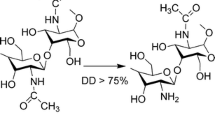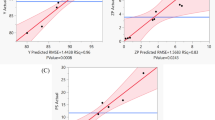Abstract
Supercritical fluid technology offers several advantages in preparation of microparticles. These include uniformity in particle size, morphology, and drug distribution without degradation of the product. One of the recent advantages is preparation of porous aerogel carrier with proper aerodynamic properties. In this study, we aimed to prepare chitosan aerogel microparticles using supercritical fluid (SCF) technology and compare that with microparticles produced by freeze drying (FD). Loading the prepared carriers with a model drug (salbutamol) was also performed. Comparisons of the particle properties and physicochemical characterizations were undertaken by evaluating particle size, density, specific surface area, and porosity. In vitro drug release studies were also investigated. The effect of many variables, such as molecular weight of chitosan oligomers, concentrations of chitosan, and concentrations of tripolyphosphate on the release, were also investigated. Chitosan aerogels were efficiently produced by SCF technology with an average particle size of 10 μm with a tapped density values around 0.12 g/mL, specific surface area (73–103) m2/g, and porosity (0.20–0.29) cc/g. Whereas, microparticles produced by FD method were characterized as cryogels with larger particle size (64 microns) with clear cracking at the surface. Sustained release profile was achieved for all prepared microparticles of salbutamol produced by the aforementioned methods as compared with pure drug. The results also demonstrates that chitosan molecular weight, polymer concentration, and tripolyphosphate concentration affected the release profile of salbutamol from the prepared microparticles. In conclusion, SCF technology was able to produce chitosan aerogel microparticles loaded with salbutamol that could be suitable for pulmonary drug delivery system.






Similar content being viewed by others
References
Ahmad FJ, Mittal G, Jain GK, Malhotra G, Khar RK, Bhatnagar A. Nano-salbutamol dry powder inhalation: a new approach for treating broncho-constrictive conditions. Eur J Pharm Biopharm. 2009;71(2):282–91.
Cook. Novel sustained release microspheres for pulmonary drug delivery. J Control Release. 2005;104:79–90.
Vehring R. Pharmaceutical particle engineering via spray drying. Pharm Res. 2008;25(5):999–1022.
Grenha A, Grainger CI, Dailey LA, Seijo B, Martin GP, Remuñán-López C, et al. Chitosan nanoparticles are compatible with respiratory epithelial cells in-vitro. Eur J Pharm Sci. 2007;31(2):73–84.
Ben-Jebria A, Eskew ML, Edwards DA. Inhalation system for pulmonary aerosol drug delivery in rodents using large porous particles. Aerosol Sci Technol. 2000;32(5):421–33.
Ben-Jebria A, Chen D, Eskew ML, Vanbever R, Langer R, Edwards DA. Large porous particles for sustained protection from carbachol-induced broncho constriction in guinea pigs. Pharm Res. 1999;16:555–61.
Chow AH, Tong HH, Chattopadhyay P, Shekunov BY. Particle engineering for pulmonary drug delivery. Pharm Res. 2007;24(3):411–37.
Tang Q, Wang T. Preparation of silica aerogel from rice hull ash by supercritical carbon dioxide drying. J Supercrit Fluids. 2005;35(1):91–4.
García-González CA, Uy JJ, Alnaief M, Smirnova I. Preparation of tailor-made starch-based aerogel microspheres by the emulsion-gelation method. Carbohydr Polym. 2012;88(4):1378–86.
García-González CA, Alnaief M, Smirnova I. Polysaccharide-based aerogels—promising biodegradable carriers for drug delivery systems. Carbohydr Polym. 2011;86(4):1425–38.
Pierre AC, Pajonk GM. Chemistry of aerogels and their applications. Chem Rev. 2002;102(11):4243–66.
Mehling T, Smirnova I, Guenther U, Neubert R. Polysaccharide-based aerogels as drug carriers. J Non-Cryst Solids. 2009;355(50-51):2472–9.
Buisson P, Hernandez C, Pierre M, Pierre A. Encapsulation of lipases in aerogels. J Non-Cryst Solids. 2001;285(1-3):295–302.
Schwertfeger F, Zimmermann A, Krempel H, inventors; Hoechst Aktiengesellschaft, assignee. Use of inorganic aerogels in pharmacy. United States patent US 6280744. 2001 Aug 28.
Krukonis V. Supercritical fluids: their proliferation in the pharma industry. Eur Pharmaceutical Contractor (EPC) May 1998.
Martín A, Cocero MJ. Micronization processes with supercritical fluids: fundamentals and mechanisms. Adv Drug Delivery Rev. 2008;60:339–50.
Pasquali I, Bettini R, Giordano F. Supercritical fluid technologies: an innovative approach for manipulating the solid-state of pharmaceuticals. Adv Drug Delivery Rev. 2008;60(3):399–410.
Zougagh M, Valcárcel M, Rıos A. Supercritical fluid extraction: a critical review of its analytical usefulness. TrAC Trends Anal Chem. 2004;23(5):399–405.
Pasquali I, Bettini R. Are pharmaceutics really going supercritical? Int J Pharm. 2008;364(2):176–87.
Reverchon E, Antonacci A. Chitosan microparticles production by supercritical fluid processing. J Supercrit Fluids. 2006;46(2):5722–8.
Nanda RK, Patil SS, Navathar DA. Chiotsan nanoparticles loaded with thiocolchicoside. Der Pharma Chemica. 2012;4(4):1619–25.
Kamble MS. Formulation & characterisation of chitosan based microspheres of salbutamol sulphate dry powder inhaler formulation. J Drug Delivery Ther. 2012;2(5):37–41.
Corrigan DO, Healy AM, Corrigan OI. Preparation and release of salbutamol from chitosan and chitosan co-spray dried compacts and multiparticulates. Eur J Pharm Biopharm. 2006;62(3):295–305.
Obaidat R, Al-Jbour N, Al-Souâ K, Sweidan K, Al-Remawi M, Badwan A. Some physico-chemical properties of low molecular weight chitosans and their relationship to conformation in aqueous solution. J Sol Chem. 2010;39:575–88.
Dhawade PP, Jagtap RN. Characterization of the glass transition temperature of chitosan and its oligomers by temperature modulated differential scanning calorimetry. Adv Appl Sci Res. 2012;3(3):1372.
Kouchak M, Avadi M, Abbaspour M, Jahangiri A, Boldaji SK. Effect of different molecular weights of chitosan on preparation and characterization of insulin loaded nanoparticles by ion gelation method. Int J Drug Dev Res. 2012;4:271–7.
El-Hefian EA, Elgannoudi ES, Mainal A, Yahaya AH. Characterization of chitosan in acetic acid: rheological and thermal studies. Turk J Chem. 2010;34:47–56.
Dong Y, Ruan Y, Wang H, Zhao Y, Bi D. Studies on glass transition temperature of chitosan with four techniques. J Appl Polym Sci. 2004;93:1553–8.
Lazaridou A, Biliaderis CG. Thermophysical properties of chitosan, chitosan–starch and chitosan–pullulan films near the glass transition. Carbohydr Polym. 2002;48:179–90.
Tsioptsias C, Michailof C, Stauropoulos G, Panayiotou C. Chitin and carbon aerogels from chitin alcogels. Carbohydr Polym. 2009;76(4):535–40.
Kačuráková M, Belton PS, Wilson RH, Hirsch J, Ebringerová A. Hydration properties of xylan-type structures: an FTIR study of xylo oligosaccharides. J Sci Food Agr. 1998;77:38–44.
Cardenas G, Miranda SP. FTIR and TGA studies of chitosan composite films. J Chil Chem Soc. 2004;49:291–5.
Elhefian EA, Nasef MM, Yahaya AH. Preparation and characterization of chitosan/agar blended films: part 2. thermal, mechanical, and surface properties. J Chem. 2012;9:510–6.
Bhumkar DR, Pokharkar VB. Studies on effect of pH on cross-linking of chitosan with sodium tripolyphosphate: a technical note. AAPS PharmSciTech. 2006;7:E138–43.
Reverchon E, Della Porta G, Pallado P. Supercritical antisolvent precipitation of salbutamol microparticles. Powder Technol. 2001;114(1–3):17–22.
Nath B, Nath LK, Mazumder B, Kumar P, Sharma N, Sahu BP. Preparation and characterization of salbutamol sulphate loaded ethyl cellulose microspheres using water-in-oil-oil emulsion technique. Iranian J Pharm Res. 2010;9(2):97–105.
Vatanara A, RouholaminiNajafabadi A, Gilani K, Asgharian R, Darabi M, Rafiee-Tehrani M. A Plackett–Burman design for screening of the operation variables in the formation of salbutamol sulphate particles by supercritical antisolvent. J Supercrit Fluids. 2007;40(1):111–6.
Jin H, Nishiyama Y, Wada M, Kuga S. Nanofibrillar cellulose aerogels. Colloids Surf A. 2004;240:63–7.
Honary S, Maleki M, Karami M. The effect of chitosan molecular weight on the properties of alginate/chitosan microparticles containing prednisolone. Trop J Pharm Res. 2009;8:53–61.
Parize AL, Stulzer HK, Laranjeira MCM, da Costa Brighente IM, de Souza TCR. Evaluation of chitosan microparticles containing curcumin and crosslinked with sodium tripolyphosphate produced by spray drying. Quim Nova. 2012;35:1127–32.
Berthold A, Cremer K, et al. Influence of crosslinking on the acid stability and physicochemical properties of chitosan microspheres. STP Pharma Sci. 1996;6(5):358–64.
Acknowledgments
This work was supported by the Jordan University of Science and Technology (grant number 13/2012).
Author information
Authors and Affiliations
Corresponding author
Rights and permissions
About this article
Cite this article
Obaidat, R.M., Tashtoush, B.M., Bayan, M.F. et al. Drying Using Supercritical Fluid Technology as a Potential Method for Preparation of Chitosan Aerogel Microparticles. AAPS PharmSciTech 16, 1235–1244 (2015). https://doi.org/10.1208/s12249-015-0312-2
Received:
Accepted:
Published:
Issue Date:
DOI: https://doi.org/10.1208/s12249-015-0312-2




